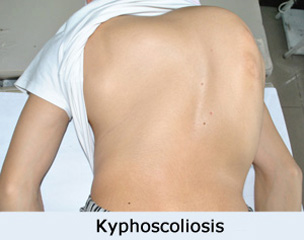Learn all about Kyphoscoliosis of thoracic spine its symptoms and treatment options.
Kyphoscoliosis is a musculoskeletal disorder, which is a combination of kyphosis and scoliosis where there is abnormal posterior and sideways curvature of the spine in both the coronal as well as the sagittal planes. Kyphoscoliosis occurring during the growth period without any obvious cause is termed as Idiopathic Kyphoscoliosis.
There are three main types of abnormal kyphosis: postural kyphosis, Scheuermann’s kyphosis, and congenital kyphosis. Kyphoscoliosis can be caused due to congenital abnormalities: Kyphoscoliosis can occur from various causes in a patient in different stages of his/her life. Kyphoscoliosis can be present from birth itself from congenital defects, such as spina bifida. Diseases of the spinal muscles and vertebrae can also cause Kyphoscoliosis.
Slouching when standing or sitting causes the spine to curve forward. Postural kyphosis is often accompanied by hyperlordosis of the lumbar (lower) spine. The lumbar spine naturally has a lordosis or inward curve. Hyperlordosis means the lumbar spine compensates for too much thoracic kyphosis by curving too far in the inward direction. Postural kyphosis corrects itself when you lie down on a flat surface, or when your spine is hyper-extended.
Kyphoscoliosis means that the patient is suffering from both types of curvature deformities, which are scoliosis and kyphosis. The selected treatment option depends on various factors such as patient’s age, the underlying cause of Kyphoscoliosis (congenital, postural) and the risks which are involved in surgery.
Kyphoscoliosis of Thoracic Spine
Spinal deformity rarely occurs in a single plane and is usually in three dimensions. It is often defined as a three-dimensional torsional deformity of the spine and trunk. Combined kyphosis and scoliosis is called Kyphoscoliosis. The thoracic curvature is between 20 degrees to 45 degrees. If this curvature increases more than 45 degrees, then it is known as kyphosis. Depending on the degree or severity of the curvature, kyphosis can cause problems, such as difficulties in breathing and digestion, cardiovascular problems and neurological deformities. If curvature of the kyphosis is severe, then it needs surgery to correct and align the spine.
Thoracic Spine Kyphoscoliosis Symptoms
The symptoms and severity of kyphosis vary depending on the type of kyphosis. Symptoms range from minor changes in the shape of your spine, to severe deformity, neurologic deficits, and chronic pain. Movement may become limited, making it difficult for you to turn and bend. The abnormal forward curvature can eventually appear unattractive. Pain may be present, especially if the kyphosis is caused by degenerative changes. The pain occurs primarily in the area of the kyphosis. A severe curve can also begin to put pressure on the spinal cord and spinal nerve roots, which may cause weakness in the lower extremities. Eventually there can be pressure on the lungs and abdomen, affecting breathing and appetite.
With a kyphotic deformity, the spinal cord may be stretched where the spine bends forward. The spinal cord is your body’s connection to your brain. When it is damaged or compressed, your body loses some of its ability to function properly. If pressure builds up on your spinal cord, it can cause myelopathy. Myelopathy may impair normal walking, hand and finger use, and bowel and bladder function. Doctors take these symptoms very seriously because severe myelopathy that is not treated may lead to permanent nerve damage. Pressure on your spinal cord can eventually lead to quadriplegia, which is paralysis of all four limbs.
Thoracic Spine Kyphoscoliosis Treatment
Treatment of disease based on the level of severity of pathological changes of other organs. When the curvature of the spinal column 1 2 the degree of focus is to create a strong muscular corset back to support the spine axis in a vertical position.List of procedures: physiotherapy, massage, acupuncture, physical therapy. Deformation of the spine is 3.4 degrees require treatment by surgery. It is carried out to restore the correct position of the vertebrae. For these purposes, use special metal rods, which are fixed, corrupted Department in the physiological position. After the operation some time, the person should walk in the gypsum. Dysplastic
kyphoscoliosis requires the restoration of a proportional relationship between bone and muscle system. To this end, the orthopedist-the traumatologist picks up reinforcing the complex gymnastics. Indications for surgical treatment:
- Low efficiency of conservative treatment with persistent pain syndrome;
- Fast progression of the disease with high probability of formation of intervertebral hernia;
- Cosmetic defects back;
- Strong curvature, hindering the functioning of the cardiovascular and respiratory systems.
In most cases, the disease responds well to treatment to 12 years, while there has been a significant growth of the vertebrae. With early detection in children, kyphoscoliosis 1 and 2 degrees can be cured during the year. In some situations, doctors can even get rid of the curvature of 3 degrees without surgical intervention.
 Health & Care Information
Health & Care Information 


